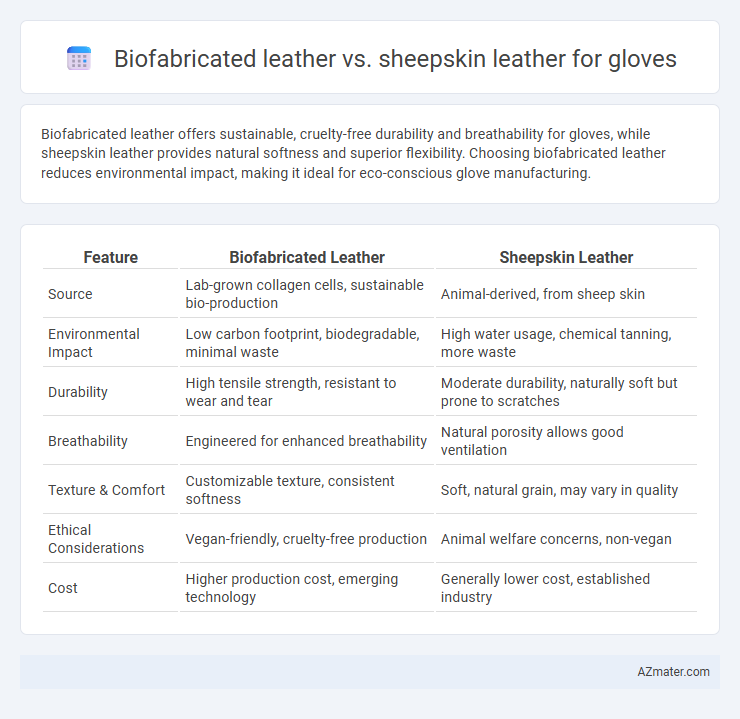Biofabricated leather offers sustainable, cruelty-free durability and breathability for gloves, while sheepskin leather provides natural softness and superior flexibility. Choosing biofabricated leather reduces environmental impact, making it ideal for eco-conscious glove manufacturing.
Table of Comparison
| Feature | Biofabricated Leather | Sheepskin Leather |
|---|---|---|
| Source | Lab-grown collagen cells, sustainable bio-production | Animal-derived, from sheep skin |
| Environmental Impact | Low carbon footprint, biodegradable, minimal waste | High water usage, chemical tanning, more waste |
| Durability | High tensile strength, resistant to wear and tear | Moderate durability, naturally soft but prone to scratches |
| Breathability | Engineered for enhanced breathability | Natural porosity allows good ventilation |
| Texture & Comfort | Customizable texture, consistent softness | Soft, natural grain, may vary in quality |
| Ethical Considerations | Vegan-friendly, cruelty-free production | Animal welfare concerns, non-vegan |
| Cost | Higher production cost, emerging technology | Generally lower cost, established industry |
Introduction to Biofabricated Leather and Sheepskin Leather
Biofabricated leather is created using lab-grown collagen fibers that mimic traditional leather's texture and durability without animal harm, offering a sustainable alternative for glove manufacturing. Sheepskin leather, derived from the hides of sheep, is prized for its softness, breathability, and natural insulation, making it a popular choice for comfortable, high-quality gloves. Both materials provide unique tactile properties and performance benefits, with biofabricated leather emerging as an eco-friendly innovation in the leather industry.
Raw Materials and Production Processes
Biofabricated leather for gloves is derived from cultured cells or plant-based proteins, bypassing the need for animal hides and reducing environmental impact through sustainable biotechnology. Sheepskin leather involves traditional tanning processes using raw sheepskin, which requires significant water, chemicals, and energy, contributing to higher ecological footprints. The biofabrication process offers precise control over material properties and waste reduction, whereas sheepskin leather production relies on agricultural livestock, impacting land use and emissions.
Sustainability and Environmental Impact
Biofabricated leather offers a sustainable alternative to sheepskin leather for gloves by significantly reducing resource consumption, including water and land use, and lowering greenhouse gas emissions during production. Sheepskin leather involves animal farming practices that contribute to deforestation, methane emissions, and ethical concerns surrounding animal welfare. Adopting biofabricated leather supports a circular economy by utilizing lab-grown materials that minimize environmental degradation and waste compared to traditional sheepskin leather manufacturing.
Durability and Longevity Comparison
Biofabricated leather for gloves offers enhanced durability through engineered fibers resistant to abrasion, moisture, and wear, often surpassing traditional sheepskin leather in lifespan. Sheepskin leather provides natural flexibility and breathability but tends to develop creases and degrade faster under heavy use due to its organic composition. Longevity tests highlight biofabricated leather's superior resistance to tearing and environmental factors, making it a more sustainable and long-lasting option for gloves.
Comfort and Breathability in Gloves
Biofabricated leather offers enhanced breathability and superior moisture-wicking properties compared to traditional sheepskin leather, making gloves more comfortable during extended wear. Sheepskin leather provides natural softness and insulation but tends to retain moisture, potentially causing discomfort in warm conditions. Advanced biofabricated materials deliver a lightweight, flexible fit with optimized air circulation, improving overall comfort and reducing sweat accumulation in glove applications.
Aesthetic and Customization Options
Biofabricated leather offers superior aesthetic versatility for gloves with its ability to mimic various textures and colors, enabling highly customized designs that meet specific fashion trends and consumer preferences. Sheepskin leather provides a classic, luxurious appearance with natural grain and softness, but customization options are limited to traditional dyeing and finishing techniques. The advanced manufacturing processes of biofabricated leather allow for precision patterning and embedded features, setting it apart in bespoke glove production.
Performance Under Various Conditions
Biofabricated leather offers superior moisture resistance and breathability compared to traditional sheepskin leather, enhancing comfort during prolonged use. Its consistent texture provides excellent durability and maintains flexibility in both hot and cold environments, outperforming sheepskin which tends to stiffen or degrade under extreme conditions. Furthermore, biofabricated leather's resistance to microbial growth ensures gloves retain hygiene and odor control after extended wear.
Cost and Market Availability
Biofabricated leather for gloves offers a cost advantage in the long term due to scalable production methods, although initial manufacturing expenses remain high compared to sheepskin leather. Sheepskin leather benefits from well-established supply chains, resulting in widespread market availability and consistent pricing. While biofabricated leather is gaining traction in niche markets focused on sustainability, sheepskin leather continues to dominate mainstream glove production due to its accessibility and proven durability.
Ethical Considerations and Animal Welfare
Biofabricated leather for gloves offers a cruelty-free alternative to traditional sheepskin leather, eliminating the need for animal slaughter and significantly reducing animal suffering. Sheepskin leather involves raising and harvesting sheep, which raises concerns about animal welfare, including living conditions, transport, and slaughter practices. Choosing biofabricated leather supports ethical manufacturing by promoting sustainable, animal-friendly production methods with minimal environmental impact.
Future Trends in Glove Manufacturing
Biofabricated leather is emerging as a sustainable alternative to traditional sheepskin leather in glove manufacturing, offering reduced environmental impact and enhanced customizability. Advances in biotechnology enable scalable production of biofabricated leather with consistent quality and improved performance characteristics such as breathability and durability. Future trends indicate increasing adoption of this innovative material driven by consumer demand for eco-friendly products and regulatory pressures limiting animal-based leather use.

Infographic: Biofabricated leather vs Sheepskin leather for Glove
 azmater.com
azmater.com